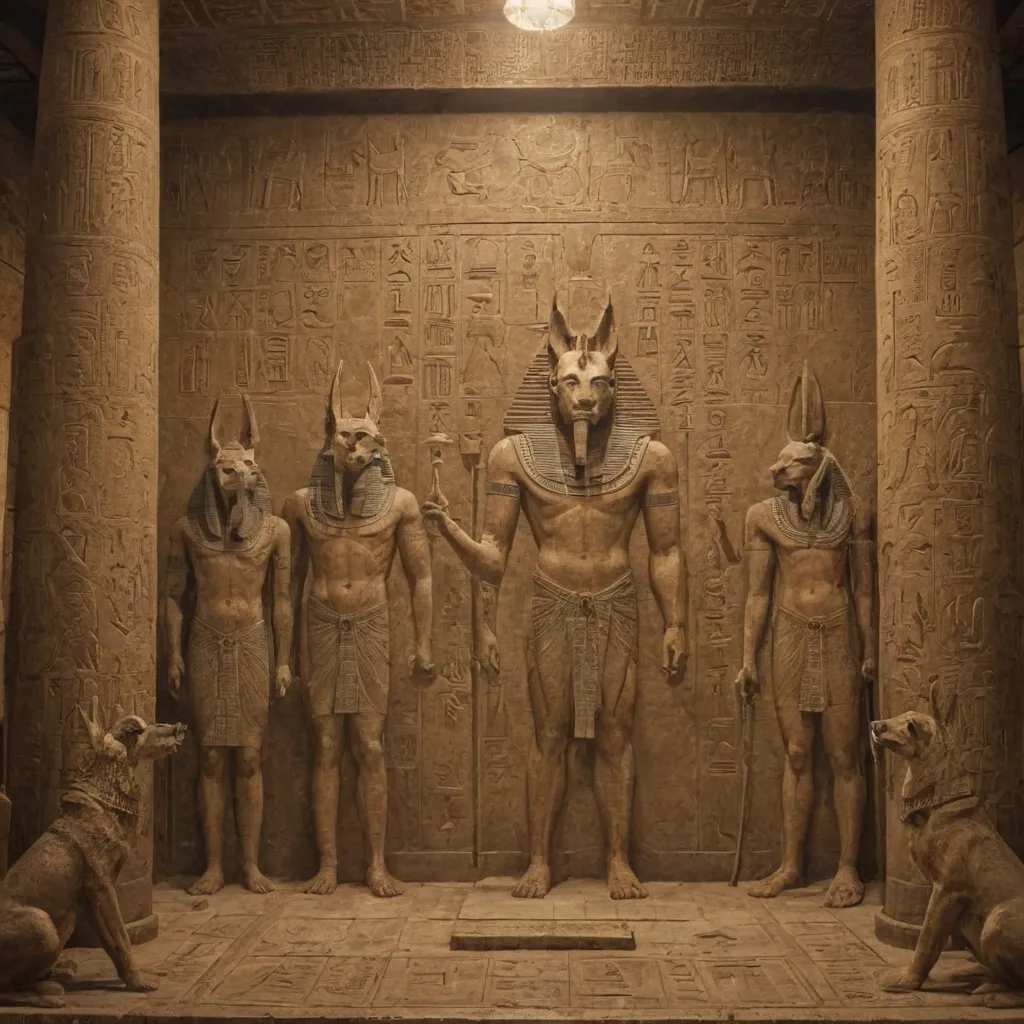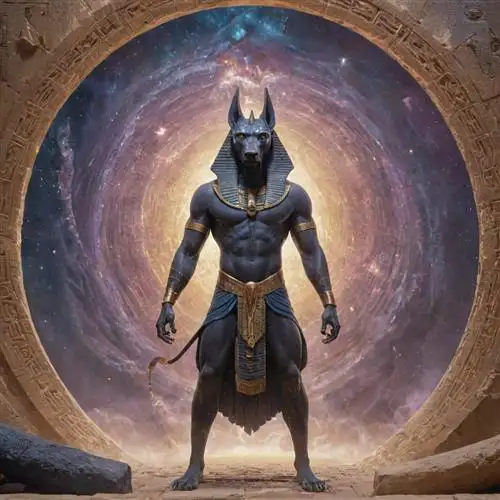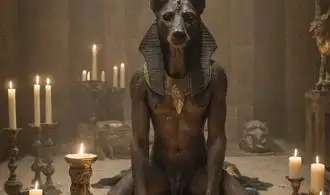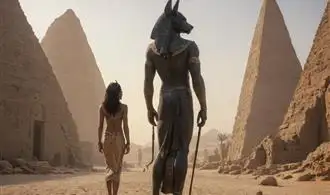
The Origins of Anubis
Anubis, the enigmatic jackal-headed deity, has long been a figure of fascination in the realm of ancient Egyptian mythology. As the god associated with mummification, embalming, and the afterlife, his origins can be traced back to the pre-dynastic period, where he likely emerged as a regional funerary deity in the region of Abydos.
The precise origins of Anubis are shrouded in mystery, with various theories and perspectives on his emergence and early development. One widely held belief is that Anubis may have evolved from the earlier cult of the wild dog or jackal, which was revered for its nocturnal habits and association with the dead. The jackal was seen as a creature that roamed the desert, the realm of the dead, and was believed to guide the souls of the deceased to the afterlife.
As the ancient Egyptian civilization evolved, the figure of Anubis became more prominent and centralized within the pantheon of deities. He was closely associated with the mummification process, with his role being to oversee the embalming of the deceased and to guide the soul of the dead through the perilous journey to the afterlife.
Interestingly, the name "Anubis" is believed to have derived from the ancient Egyptian word "Inpu," which may have referred to a specific type of jackal or dog. This linguistic connection further reinforces the notion that Anubis originated as a regional deity with strong associations to the natural world and the rituals surrounding death and the afterlife.
The iconography of Anubis also evolved over time, with the jackal-headed deity being depicted in various postures and contexts. He was often shown standing guard over the embalming table, kneeling beside the mummy, or accompanying the deceased on their journey to the afterlife. These visual representations helped solidify Anubis' role as a pivotal figure in the ancient Egyptian conception of the afterlife and the rituals surrounding death and burial.
The Role of Anubis in the Afterlife
Anubis, the jackal-headed deity, played a pivotal role in the ancient Egyptian conception of the afterlife. As the god of embalming and the protector of the dead, Anubis held a crucial responsibility in guiding the deceased through the intricate process of the afterlife. His presence was integral to the sacred rituals and beliefs surrounding death and the journey beyond.
At the heart of Anubis' role in the afterlife was his role as the conductor of the weighing of the heart ceremony. This ritual, a crucial step in the journey to the afterlife, involved the deceased's heart being weighed against the feather of truth, symbolizing the individual's moral worthiness. Anubis, with his keen judgment and unwavering dedication to justice, would oversee this solemn proceeding, ensuring the deceased's heart was found to be pure and virtuous. Only then could the individual proceed to the next stage of their eternal journey.
But Anubis' influence extended far beyond this pivotal ceremony. As the god of embalming, he was responsible for the mummification process, ensuring the body of the deceased was properly prepared for the afterlife. This intricate ritual, which involved the removal of the internal organs and the careful preservation of the body, was believed to be essential for the soul's transition to the afterlife. Anubis' steady hand and meticulous care in this process were regarded as vital for the deceased's successful passage to the next life.
Furthermore, Anubis was believed to be the guardian of the necropolis, the sacred burial ground where the dead were laid to rest. His presence in this hallowed space was seen as a protective and guiding force, ensuring the deceased were safe and their final resting place was secure. This role as the protector of the dead further solidified Anubis' integral position in the ancient Egyptian conception of the afterlife.
Anubis and the Mummification Process
Anubis, the jackal-headed deity of ancient Egyptian mythology, played a crucial role in the mummification process and the journey to the afterlife. As the god of embalming and the protector of the dead, Anubis oversaw every step of the complex and meticulous mummification ritual, ensuring the deceased's successful transition to the next world.
At the heart of the mummification process was the belief that the physical body needed to be preserved in order to ensure the soul's immortality. Anubis, with his keen understanding of the human body and the mysteries of death, was the guiding force behind this intricate procedure. The jackal-headed god would first preside over the evisceration of the body, carefully removing the internal organs and placing them in canopic jars to be preserved separately. This delicate task was essential, as it allowed the body to be dried and preserved without the risk of decay.
Following the evisceration, Anubis would oversee the drying and embalming of the body. The deceased would be packed in natron, a salt-like substance, for a period of 40 days, during which time the body would be slowly dehydrated and the soft tissues would be removed. Once the body was fully dried, Anubis would then anoint it with a variety of oils and resins, creating a protective barrier that would prevent the mummy from deteriorating over time.
The final step in the mummification process was the wrapping of the body in linen bandages. Anubis, with his deft and meticulous touch, would carefully wrap the mummy, ensuring that every inch of the body was protected and preserved. This act of wrapping the deceased was seen as a symbolic rebirth, with Anubis playing the role of a midwife, guiding the soul into the next life.
Symbolic Representations of Anubis
Anubis, the jackal-headed Egyptian deity, is one of the most iconic and enigmatic figures of the ancient world. As the god associated with the afterlife, his symbolic representations hold profound significance in understanding the beliefs and practices of ancient Egyptian civilization. From his physical depiction to the various rituals and objects associated with him, the symbolic language of Anubis provides a window into the intricate and multifaceted nature of Egyptian spirituality.
The jackal-headed form of Anubis is perhaps the most recognizable and enduring symbol of this deity. The jackal, a cunning and adaptable canine, was chosen as Anubis' physical embodiment for a reason. Jackals were often associated with the liminal spaces between the living and the dead, as they were known to scavenge in cemeteries and burial grounds. This connection to the realm of the dead made the jackal an apt representation for the god who oversaw the transition from life to the afterlife.
In addition to his jackal-headed form, Anubis is often depicted holding specific objects or performing rituals that hold deep symbolic meaning. One of the most significant symbols associated with Anubis is the black color of his skin. The black hue was believed to represent the color of the fertile soil of the Nile River, which was essential for the growth and sustenance of life. This connection to the land of the living reinforced Anubis' role as a guardian and guide for the deceased, helping them navigate the journey to the afterlife.
Another important symbolic representation of Anubis is the "Weighing of the Heart" ritual, in which the deceased's heart is weighed against the feather of truth. This ritual, depicted in numerous ancient Egyptian funerary texts and artworks, symbolized the judgment of the soul. Anubis was responsible for overseeing this critical moment, ensuring the deceased had lived a righteous life and were deemed worthy of entering the afterlife.
The various objects associated with Anubis, such as the crook and flail, also hold deep symbolic meaning. The crook, a symbol of shepherding, represented Anubis' role as a guide and protector of the dead, leading them through the treacherous journey to the afterlife. The flail, on the other hand, was a symbol of royal authority, further reinforcing Anubis' position as a powerful and influential deity in the Egyptian pantheon.
The symbolic representations of Anubis are not limited to his physical form and the objects he is depicted holding. The rituals and ceremonies associated with this deity, such as the mummification process and the funerary rites, also hold profound symbolic significance. These practices were designed to ensure the smooth transition of the deceased into the afterlife, with Anubis playing a crucial role in guiding and protecting the soul throughout this journey.
The Cult of Anubis in Ancient Egypt
The Cult of Anubis in Ancient Egypt was a significant aspect of the Egyptian religious and cultural landscape. Anubis, the jackal-headed god, was a central figure in the rituals and beliefs surrounding the afterlife. As the god of mummification and the underworld, Anubis played a crucial role in the journey of the deceased through the afterlife.
Ancient Egyptians believed that Anubis was responsible for the embalming process, ensuring the proper preservation of the body for the deceased's journey to the afterlife. The cult of Anubis was centered around the practice of mummification, and priests who specialized in this process were highly revered. They would meticulously prepare the body for the afterlife, following strict rituals and protocols to ensure the soul's safe passage.
The role of Anubis extended beyond the embalming process. He was also believed to be the guardian of the deceased, protecting them during their journey to the afterlife. As the god of the underworld, Anubis was responsible for weighing the heart of the deceased against the feather of truth, a crucial step in the afterlife judgment process. This ritual, known as the "Weighing of the Heart," determined whether the soul would be granted eternal life or condemned to eternal damnation.
The cult of Anubis was not limited to a specific region or location in ancient Egypt. Anubis was worshipped across the country, with temples and shrines dedicated to him in various cities and necropolis sites. These places of worship were often located near important burial grounds, reflecting the strong connection between Anubis and the afterlife.
Anubis was also closely associated with other deities in the Egyptian pantheon, particularly Osiris, the god of the underworld. The relationship between Anubis and Osiris was complex, with Anubis serving as a protector and guide for the deceased as they journeyed to the realm of Osiris. Discover How Anubis Can Protect You From the Afterlife and the significance of this connection in the Egyptian belief system.















